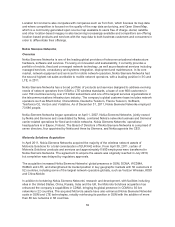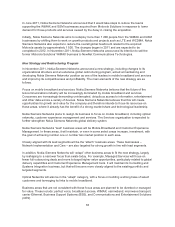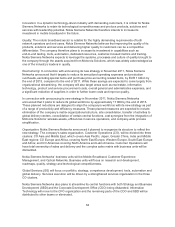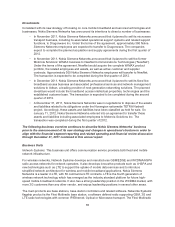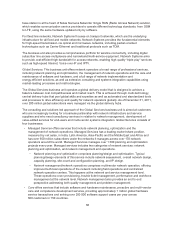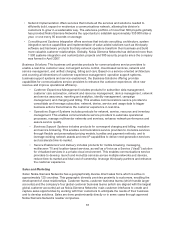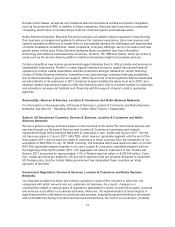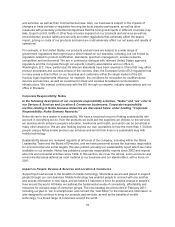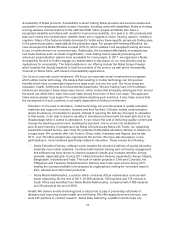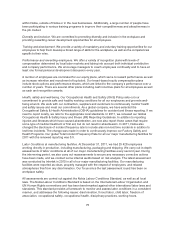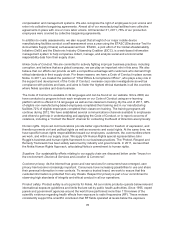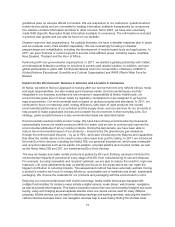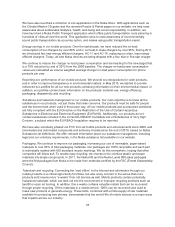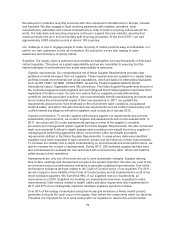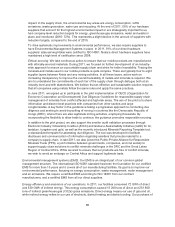Nokia 2011 Annual Report Download - page 72
Download and view the complete annual report
Please find page 72 of the 2011 Nokia annual report below. You can navigate through the pages in the report by either clicking on the pages listed below, or by using the keyword search tool below to find specific information within the annual report.comprising IPR that was transferred from its parent companies at formation and IPR filed since its start
of operations. Nokia Siemens Networks is a world leader in the research and development of wireless
technologies, as well as transport and broadband technologies, and it has robust patent portfolios in a
broad range of technology areas. The IPR portfolio includes standards-related essential patents and
patent applications that have been declared by Nokia and Siemens. Nokia Siemens Networks has
declared its own essential patents and patent applications based on evaluation of pending cases with
respect to standards. Nokia Siemens Networks receives and pays certain patent license royalties in the
ordinary course of its business based on existing agreements with telecommunication vendors.
Competition
Conditions in the market for mobile and fixed network infrastructure and related services improved, but
remained challenging and intensely competitive in 2011. The market continued to be characterized by
mixed trends as growth in mobile broadband and services was offset by equipment price erosion, a
maturing of legacy industry technology and intense price competition.
Industry participants have changed significantly in recent years. Substantial industry consolidation
occurred in 2007 with the emergence of three major European vendors: Alcatel-Lucent, Ericsson and
Nokia Siemens Networks. The break-up of Nortel occurred in 2009 when it entered bankruptcy
protection and many parts of the business were sold, including the wireless carrier unit, Metro Ethernet
Networks, and its GSM business. In January 2011, Motorola Solutions completed its separation from
Motorola Mobility Holdings Inc. In April 2011, Nokia Siemens Networks acquired the majority of
Motorola Solutions’ wireless network infrastructure assets.
During 2011, the competitive environment in the telecommunications infrastructure market was
characterized by continued overall growth in global network operators’ capital expenditures in Euro
terms, mainly attributable to the Japanese, Chinese, APAC, North East Europe and Latin American
markets. Growth in capital expenditures declined in the Middle East and remained relatively
unchanged in the European and North American markets in Euro terms in 2011. Increased smart
phone usage drove increased investments in the United States and European wireless markets. The
vendors from China, Huawei and ZTE, continued to grow their market share but at a slower pace than
in previous years and continued to challenge Alcatel-Lucent, Ericsson and Nokia Siemens Networks.
Nokia Siemens Networks’ ability to compete with low-cost vendors primarily depends on its ability to be
price competitive and, in certain circumstances, its ability to provide or facilitate vendor financing. In
recent years, the technological capabilities of the Chinese vendors, particularly Huawei, has improved
significantly, resulting in competition not only on price but also on quality. In addition to the major
infrastructure providers, Nokia Siemens Networks also competes with Cisco and NEC.
In the Networks Systems business, the decline of 2G (GSM, CDMA) continued in 2011, whereas
investments in 3G continued and increased worldwide. Also, fourth generation (4G) LTE trials and
pilots continued strongly as operators continued to merge towards next generation LTE and all-IP
networks. Within the LTE segment, leading vendors are competing based on factors including
technology innovation, network typology and less complex network architectures as well as integration
towards all-IP networks.
Growth in wireline and wireless broadband services sped up optical and wireless network upgrades in
developed markets. In addition, the related investment in mobile backhaul networks continued to
increase due to data traffic increases in the operator networks.
In services, which remained the fastest growing part of the industry, competition is generally based on
a vendor’s ability to identify and solve customer problems rather than their ability to supply equipment
at a competitive price. Competition in services is from both traditional vendors such as Alcatel-Lucent,
70




